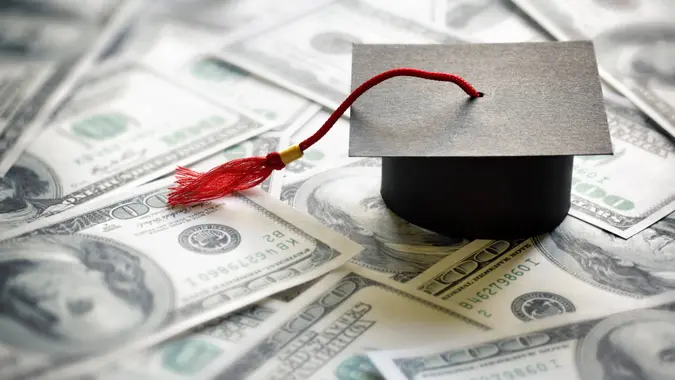How To Trade In a Car That Is Not Paid Off: A Step-by-Step Guide

Commitment to Our Readers
GOBankingRates' editorial team is committed to bringing you unbiased reviews and information. We use data-driven methodologies to evaluate financial products and services - our reviews and ratings are not influenced by advertisers. You can read more about our editorial guidelines and our products and services review methodology.

20 Years
Helping You Live Richer

Reviewed
by Experts

Trusted by
Millions of Readers
Wondering if you can trade in a car that isn’t paid off? You certainly can, but it might not work in your favor if you owe more on the loan than the car’s trade-in value or equity.
You may still be able to trade in the car, but you’ll need to pay the difference between your car’s value and the loan payoff amount. Here’s how the process might work for different scenarios.
Can You Trade In a Car You Still Owe Money On?
You can trade in a car even if you have a balance on the loan. Ideally, the trade-in value exceeds the loan balance. The money from your trade-in will go toward paying off the loan. If you’ve taken good care of the car, have low mileage and the car has retained its value, you might even walk away with some cash. It all depends on the loan balance vs. trade-in value.
Ideally, if your car has positive equity – meaning, it has more value than the loan balance – you’ll be in good shape for a trade-in. If the car has negative equity, which means you owe more than the car is worth, you still have options to trade in the vehicle. Ultimately, it will cost more money.
What Dealers Consider Before Accepting a Trade-In
Dealers evaluate many of the same elements that an individual shopping for a used vehicle would consider. These include:
- Trade-in value
- Condition
- Mileage
- Market demand, especially locally
- Equity
How To Trade In a Car That’s Not Paid Off: Step-by-Step Guide
Trading in a car with a loan can be done in several ways, depending on how much your vehicle is valued. Here are the steps to get started.
1. Check Your Loan Balance
Request the loan payoff amount from your lender. This might also be listed online or on your statement. Note that the payoff amount may differ from your current balance, according to the Consumer Financial Protection Bureau. The payoff amount also includes interest due up to the date you want to pay off the loan, as well as any additional fees.
2. Determine Your Car’s Trade-In Value
With your loan payoff amount in mind, compare that to your car’s trade-in value. Use sources like Kelley Blue Book or Edmunds to determine how much your car is worth. To get an accurate estimate, you’ll need:
- The vehicle’s make, model and year
- Trim package and other features
- Mileage
- Condition
- VIN (Vehicle Identification Number)
Even then, that’s just the “book value” and a starting point for negotiations. Visit multiple dealers to find out how much they are willing to pay for your trade-in. If a specific vehicle is in high demand in your area, a dealer may be willing to pay more.
Calculate Your Equity
Once you’ve gotten some reliable quotes, determine if your car has positive equity or negative equity. If the trade-in value is higher than the loan balance, you can use that equity toward your new car. If the trade-in value is lower than the loan balance, you may need to cover the difference.
4. Explore Your Options if You Have Negative Equity
Negative equity doesn’t mean you can’t make a deal. You have several options to pay off the old loan.
Pay the Difference Out of Pocket
If you have cash available, you can pay the difference before taking out a new loan. This is the ideal option, since you won’t be stuck paying for a car you no longer own over the long term.
Roll Over the Equity into a New Loan
Some dealers will allow you to roll the remaining loan balance into your new car loan. This will increase your loan-to-value ratio along with the total loan amount, which could result in higher monthly payments.
Sell the Car Privately
You can try to sell the car privately at a higher price than the trade-in value. Then, you can use that cash to pay off your loan.
Refinance the Current Loan
Consider refinancing the current loan at a lower interest rate. This can reduce the payoff amount and loan balance, resulting in more equity. You might consider holding onto your older car for a few months to get the loan balance down further. When you refinance, run the numbers, including loan origination fees, to make sure it’s worth the time and money.
Negotiate the Trade-In Offer
If you’ve decided to trade in your vehicle, compare all the offers. Keep dealer inventory in mind, since you’ll want to find a new car at the same dealer. If you have negative equity in your current vehicle, ask if the dealer offers negative equity assistance.
Pay Attention
Some dealers may promise to “pay off your old vehicle,” but they roll the negative equity into the new loan. This must be disclosed on the contract.
6. Finalize the Trade-In and New Loan, if Applicable
After the time spent negotiating and car shopping, you’re finally ready to close on your new car. The dealer pays off the remaining loan balance with your car’s trade-in value. Any negative equity may be rolled into the new loan unless you’ve paid it separately. Read the contract carefully to determine what happened with the previous loan.
It’s a good idea to create a checklist of things to do before trading in a car with an outstanding loan. The list should include:
- Check your loan payoff amount
- Negotiate your vehicle’s trade-in value with the dealer
- Decide how you want to handle any negative equity
- Read your contract carefully
Trade-In With a Loan: Quick Reference Table
| Scenario | Trade-In Value | Loan Balance | Outcome |
|---|---|---|---|
| Positive equity | $15,000 | $10,000 | $5,000 equity applied to new car |
| Break-even | $12,000 | $12,000 | Loan fully covered, no extra costs |
| Negative equity | $10,000 | $14,000 | $4,000 must be paid or rolled into new loan |
Final Thoughts
You can trade in a car with an outstanding loan, regardless of the vehicle’s equity. It requires more careful planning, though. You may not walk away with cash in hand for a down payment on a new car.
Before you decide how to handle your outstanding loan balance, consider all your options. You may want to refinance the loan, sell the vehicle privately or pay off the loan with cash before trading in your vehicle.
How To Trade In a Car That Is Not Paid Off: FAQ
If you're looking for answers about paying off a car with negative equity, take a look below.- Can I trade in my car if I still owe money on it?
- Yes, you can trade in your car even if you still owe on the loan. If your car is worth more than what you owe, the additional value can cover the loan. However, if you owe more than what the car is worth, then it's considered negative equity and you'll need to decide how to pay off the loan first.
- What happens to my loan when I trade in my car?
- When you trade in a car with an existing loan, the dealer may pay off the loan using your car's value in the trade-in. However, if your trade-in doesn't cover the loan payoff amount, you can roll the loan into your new car loan. The dealer must disclose how they are handling the negative equity.
- How do I know if I have positive or negative equity?
- To determine the equity in your vehicle, compare your loan payoff amount to your vehicle's value. If the vehicle's value is higher than the loan amount, you have positive equity. If the vehicle's value is lower than the loan amount, you have negative equity.
- Can I trade in a car with negative equity?
- You can trade in a car with negative equity, but you'll need to determine the best way to pay off your current car loan first.
- Should I pay off my loan before trading in my car?
- Ideally, if you can pay off your car loan before trading in your car, you should. If you don't have an existing car loan, the money you receive from trading in your car can go toward the down payment on the new vehicle.
- Can I trade in my car with the same lender?
- You can trade in your car at the same dealership where you purchased it, or with the same lender that holds the loan to your current vehicle. You might even get a better interest rate since you have an established credit history with that lender.
- What are my options if I can't afford the negative equity?
- If you can't afford to pay off the negative equity in your vehicle before purchasing a new car, you can try to refinance the loan, continue making payments for a few months, or roll the negative equity into a new car loan.
- Is it better to sell my car privately instead of trading it in?
- You can often get more money selling a car privately instead of trading it in. However, you'll have to handle all the marketing to find a buyer.
Our in-house research team and on-site financial experts work together to create content that’s accurate, impartial, and up to date. We fact-check every single statistic, quote and fact using trusted primary resources to make sure the information we provide is correct. You can learn more about GOBankingRates’ processes and standards in our editorial policy.
 Written by
Written by  Edited by
Edited by 






















